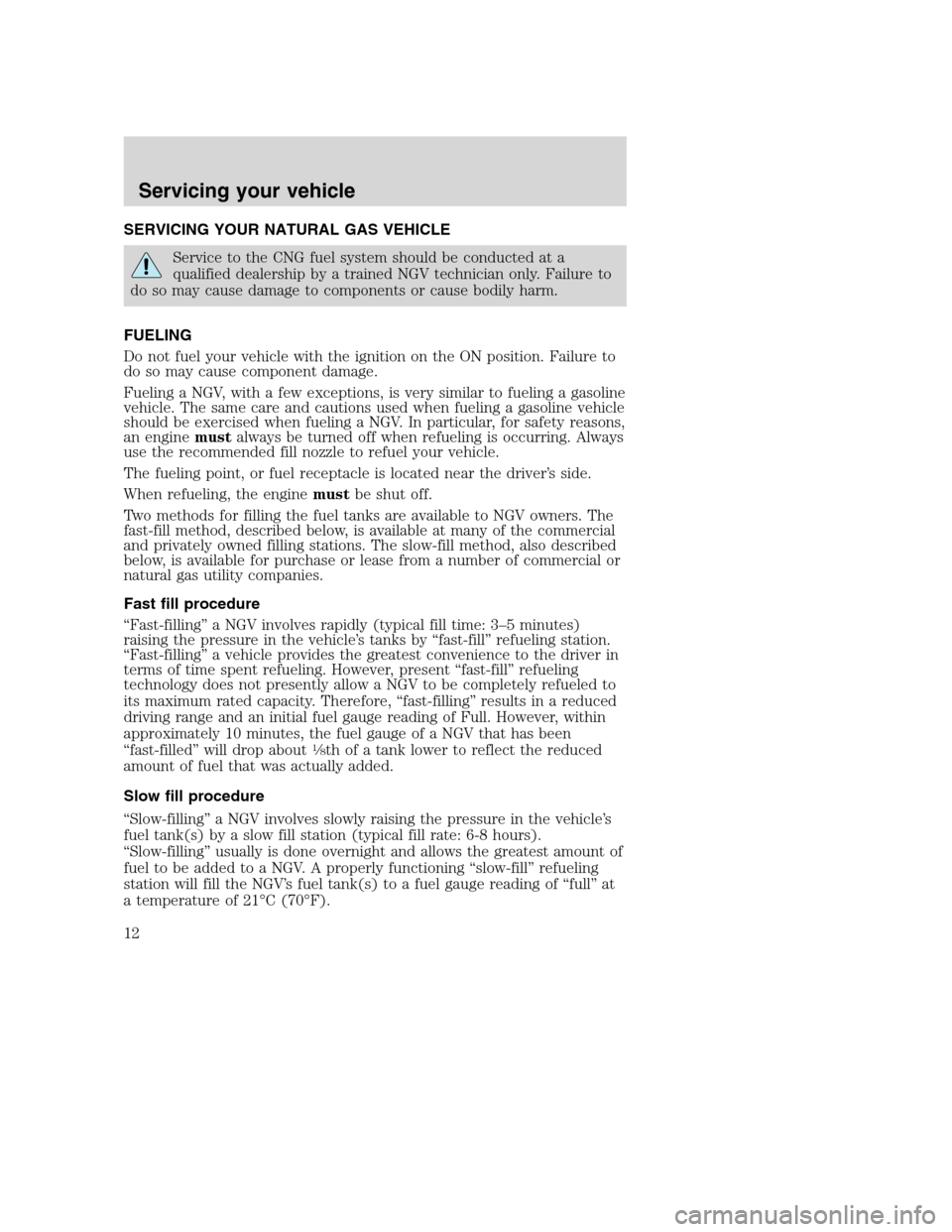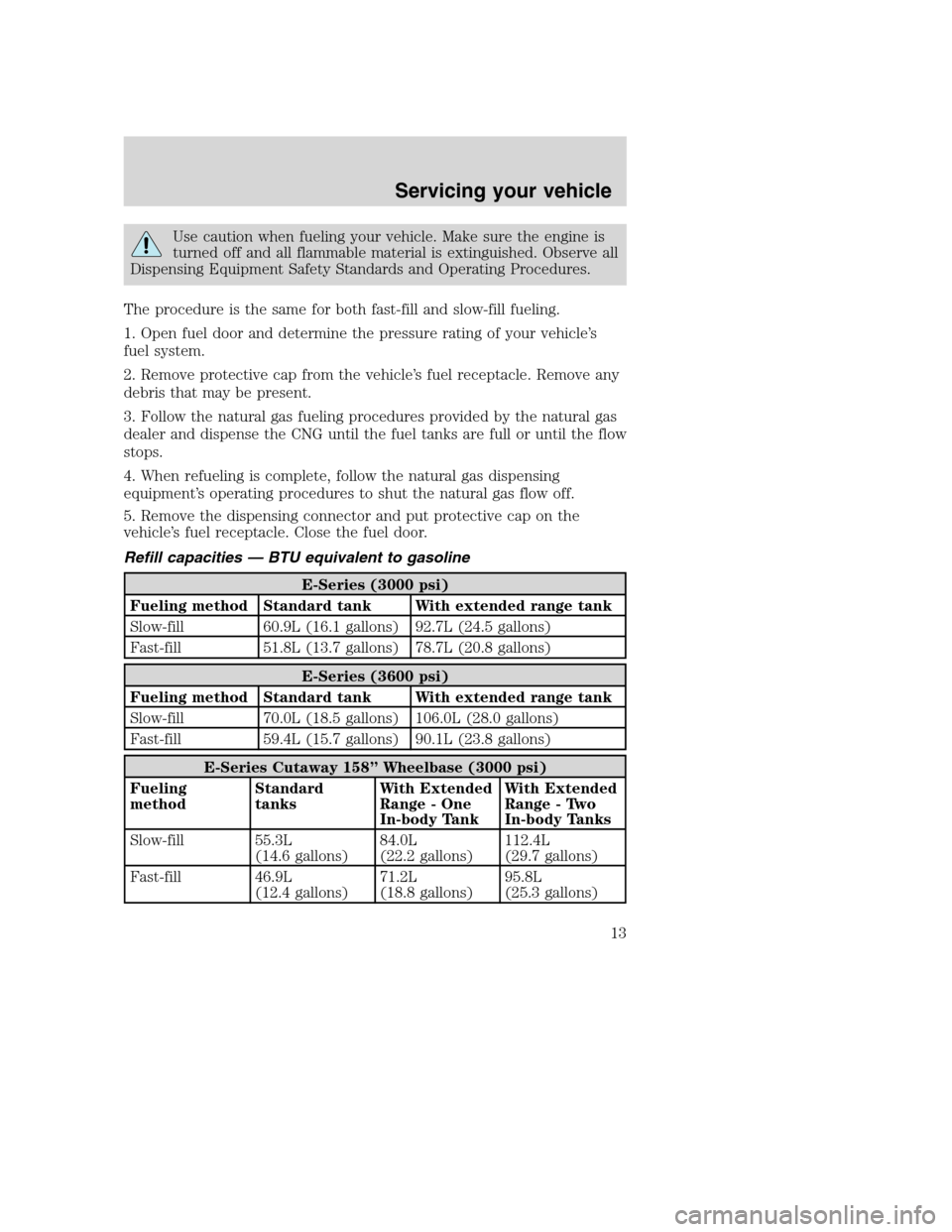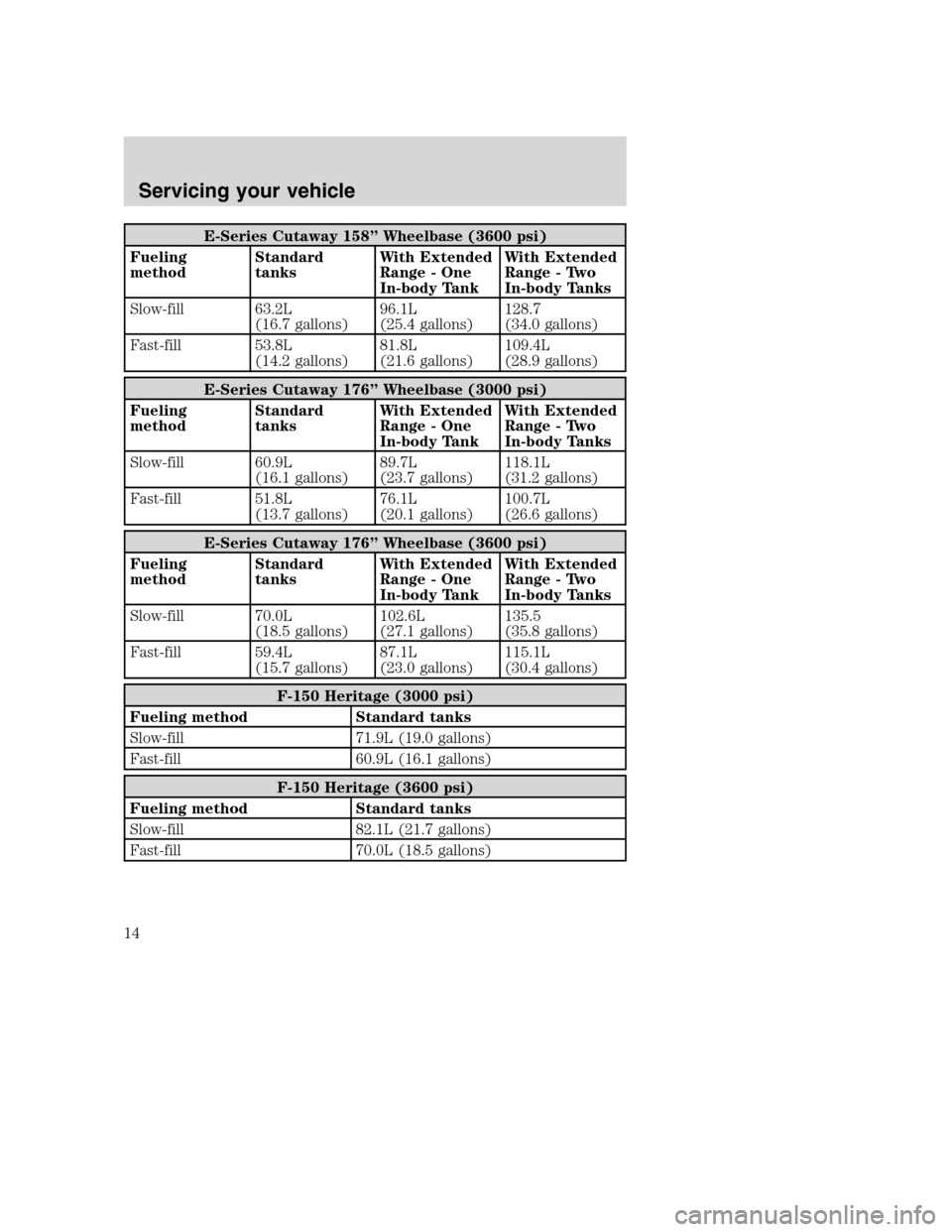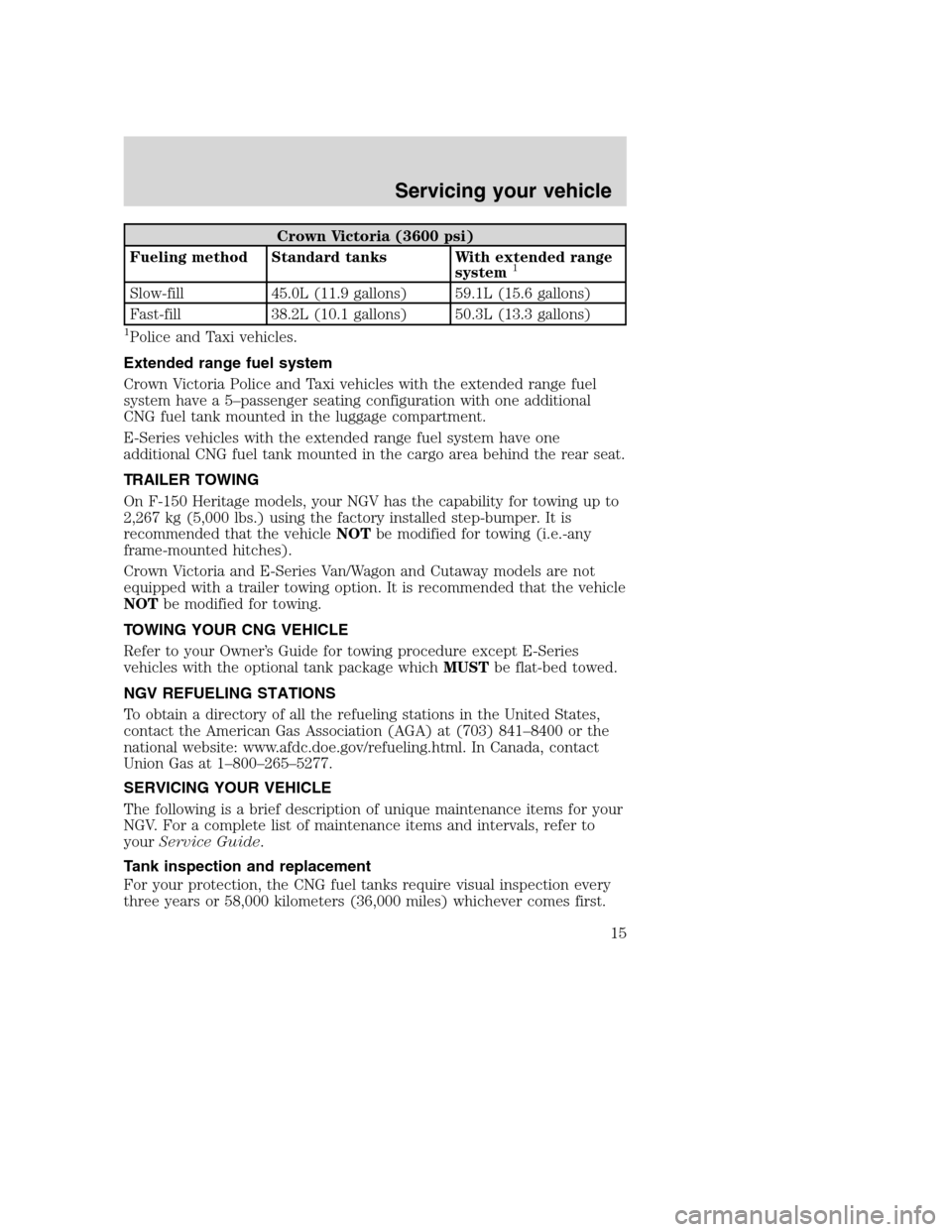FORD E SERIES 2004 4.G Natural Gas Vehicle Supplement Manual
Manufacturer: FORD, Model Year: 2004, Model line: E SERIES, Model: FORD E SERIES 2004 4.GPages: 16, PDF Size: 0.12 MB
Page 11 of 16

indication that refueling is nearly complete. Also, the station compression
equipment may turn on at any time during the refueling process.
FUEL QUALITY
Do not use liquefied natural gas (LNG) or a CNG that is derived
from a process such as flashing (heating LNG). Failure to use the
correct type of fuel may cause damage to the engine and fuel
system components.
Use only a CNG fuel that meets the specification of NFPA-52 and SAE
J1616 in your NGV. Specifications NFPA-52 and SAE J1616 place limits
on particulate contamination, oil contamination and moisture content to
ensure a quality CNG fuel.
The use of a CNG fuel that does not meet specifications NFPA-52 and
SAE J1616 isnot recommended and may cause engine damage.
Use of poor quality CNG fuel may result in:
• component failure.
• leakage from the fueling point.
• poor vehicle operation.
Use of poor quality fuel may also result in your warranty being
invalidated.
Icing while fueling your vehicle
An icing condition may occur after fueling your vehicle. This may be due
to changes in fuel moisture content, quite often seen during change of
seasons. This condition causes your vehicle ’s fuel fill valve to remain
slightly open, allowing some natural gas to be released.
Breathing hydrocarbon gases (CNG) or air which lacks oxygen
due to the presence of hydrocarbon gases can result in
headache, dizziness and weakness in the arms and legs. In the event of
illness due to inhaling hydrocarbon gases, immediately move the victim
to fresh air and contact medical emergency personnel.
The icing condition may be observed when disconnecting the fuel
dispenser ’s fill nozzle from your vehicle. You may notice more gas than
normal venting from the vehicle fill valve through the vent hose to the
dispenser. If this occurs, keep the fill nozzle connected (or reconnect it)
and wait about 30 seconds. This will allow the ice to melt. Repeat this
procedure as necessary. When normal fuel venting occurs, remove the fill
nozzle and stow it as instructed on the dispenser.
Do not fuel your vehicle with the ignition in the ON position; doing so
may increase the amount of fuel venting during this icing condition.
Servicing your vehicle
11
Page 12 of 16

SERVICING YOUR NATURAL GAS VEHICLE
Service to the CNG fuel system should be conducted at a
qualified dealership by a trained NGV technician only. Failure to
do so may cause damage to components or cause bodily harm.
FUELING
Do not fuel your vehicle with the ignition on the ON position. Failure to
do so may cause component damage.
Fueling a NGV, with a few exceptions, is very similar to fueling a gasoline
vehicle. The same care and cautions used when fueling a gasoline vehicle
should be exercised when fueling a NGV. In particular, for safety reasons,
an enginemustalways be turned off when refueling is occurring. Always
use the recommended fill nozzle to refuel your vehicle.
The fueling point, or fuel receptacle is located near the driver’s side.
When refueling, the enginemustbe shut off.
Two methods for filling the fuel tanks are available to NGV owners. The
fast-fill method, described below, is available at many of the commercial
and privately owned filling stations. The slow-fill method, also described
below, is available for purchase or lease from a number of commercial or
natural gas utility companies.
Fast fill procedure
“Fast-filling”a NGV involves rapidly (typical fill time: 3–5 minutes)
raising the pressure in the vehicle’s tanks by“fast-fill”refueling station.
“Fast-filling”a vehicle provides the greatest convenience to the driver in
terms of time spent refueling. However, present“fast-fill”refueling
technology does not presently allow a NGV to be completely refueled to
its maximum rated capacity. Therefore,“fast-filling”results in a reduced
driving range and an initial fuel gauge reading of Full. However, within
approximately 10 minutes, the fuel gauge of a NGV that has been
“fast-filled”will drop about
1⁄8th of a tank lower to reflect the reduced
amount of fuel that was actually added.
Slow fill procedure
“Slow-filling” a NGV involves slowly raising the pressure in the vehicle’s
fuel tank(s) by a slow fill station (typical fill rate: 6-8 hours).
“Slow-filling” usually is done overnight and allows the greatest amount of
fuel to be added to a NGV. A properly functioning “slow-fill” refueling
station will fill the NGV’s fuel tank(s) to a fuel gauge reading of “full” at
a temperature of 21°C (70°F).
Servicing your vehicle
12
Page 13 of 16

Use caution when fueling your vehicle. Make sure the engine is
turned off and all flammable material is extinguished. Observe all
Dispensing Equipment Safety Standards and Operating Procedures.
The procedure is the same for both fast-fill and slow-fill fueling.
1. Open fuel door and determine the pressure rating of your vehicle’s
fuel system.
2. Remove protective cap from the vehicle’s fuel receptacle. Remove any
debris that may be present.
3. Follow the natural gas fueling procedures provided by the natural gas
dealer and dispense the CNG until the fuel tanks are full or until the flow
stops.
4. When refueling is complete, follow the natural gas dispensing
equipment’s operating procedures to shut the natural gas flow off.
5. Remove the dispensing connector and put protective cap on the
vehicle’s fuel receptacle. Close the fuel door.
Refill capacities — BTU equivalent to gasoline
E-Series (3000 psi)
Fueling method Standard tank With extended range tank
Slow-fill 60.9L (16.1 gallons) 92.7L (24.5 gallons)
Fast-fill 51.8L (13.7 gallons) 78.7L (20.8 gallons)
E-Series (3600 psi)
Fueling method Standard tank With extended range tank
Slow-fill 70.0L (18.5 gallons) 106.0L (28.0 gallons)
Fast-fill 59.4L (15.7 gallons) 90.1L (23.8 gallons)
E-Series Cutaway 158” Wheelbase (3000 psi)
Fueling
methodStandard
tanksWith Extended
Range - One
In-body TankWith Extended
Range - Two
In-body Tanks
Slow-fill 55.3L
(14.6 gallons)84.0L
(22.2 gallons)112.4L
(29.7 gallons)
Fast-fill 46.9L
(12.4 gallons)71.2L
(18.8 gallons)95.8L
(25.3 gallons)
Servicing your vehicle
13
Page 14 of 16

E-Series Cutaway 158”Wheelbase (3600 psi)
Fueling
methodStandard
tanksWith Extended
Range - One
In-body TankWith Extended
Range - Two
In-body Tanks
Slow-fill 63.2L
(16.7 gallons)96.1L
(25.4 gallons)128.7
(34.0 gallons)
Fast-fill 53.8L
(14.2 gallons)81.8L
(21.6 gallons)109.4L
(28.9 gallons)
E-Series Cutaway 176”Wheelbase (3000 psi)
Fueling
methodStandard
tanksWith Extended
Range - One
In-body TankWith Extended
Range - Two
In-body Tanks
Slow-fill 60.9L
(16.1 gallons)89.7L
(23.7 gallons)118.1L
(31.2 gallons)
Fast-fill 51.8L
(13.7 gallons)76.1L
(20.1 gallons)100.7L
(26.6 gallons)
E-Series Cutaway 176”Wheelbase (3600 psi)
Fueling
methodStandard
tanksWith Extended
Range - One
In-body TankWith Extended
Range - Two
In-body Tanks
Slow-fill 70.0L
(18.5 gallons)102.6L
(27.1 gallons)135.5
(35.8 gallons)
Fast-fill 59.4L
(15.7 gallons)87.1L
(23.0 gallons)115.1L
(30.4 gallons)
F-150 Heritage (3000 psi)
Fueling method Standard tanks
Slow-fill 71.9L (19.0 gallons)
Fast-fill 60.9L (16.1 gallons)
F-150 Heritage (3600 psi)
Fueling method Standard tanks
Slow-fill 82.1L (21.7 gallons)
Fast-fill 70.0L (18.5 gallons)
Servicing your vehicle
14
Page 15 of 16

Crown Victoria (3600 psi)
Fueling method Standard tanks With extended range
system
1
Slow-fill 45.0L (11.9 gallons) 59.1L (15.6 gallons)
Fast-fill 38.2L (10.1 gallons) 50.3L (13.3 gallons)
1Police and Taxi vehicles.
Extended range fuel system
Crown Victoria Police and Taxi vehicles with the extended range fuel
system have a 5–passenger seating configuration with one additional
CNG fuel tank mounted in the luggage compartment.
E-Series vehicles with the extended range fuel system have one
additional CNG fuel tank mounted in the cargo area behind the rear seat.
TRAILER TOWING
On F-150 Heritage models, your NGV has the capability for towing up to
2,267 kg (5,000 lbs.) using the factory installed step-bumper. It is
recommended that the vehicleNOTbe modified for towing (i.e.-any
frame-mounted hitches).
Crown Victoria and E-Series Van/Wagon and Cutaway models are not
equipped with a trailer towing option. It is recommended that the vehicle
NOTbe modified for towing.
TOWING YOUR CNG VEHICLE
Refer to your Owner’s Guide for towing procedure except E-Series
vehicles with the optional tank package whichMUSTbe flat-bed towed.
NGV REFUELING STATIONS
To obtain a directory of all the refueling stations in the United States,
contact the American Gas Association (AGA) at (703) 841–8400 or the
national website: www.afdc.doe.gov/refueling.html. In Canada, contact
Union Gas at 1–800–265–5277.
SERVICING YOUR VEHICLE
The following is a brief description of unique maintenance items for your
NGV. For a complete list of maintenance items and intervals, refer to
yourService Guide.
Tank inspection and replacement
For your protection, the CNG fuel tanks require visual inspection every
three years or 58,000 kilometers (36,000 miles) whichever comes first.
Servicing your vehicle
15
Page 16 of 16

The purpose of the inspection is to check for exterior damage to the
tank which would shorten its usable life span. This inspection should
only be done by qualified NGV Ford service technicians.
The expiration date for the tank replacement is stated on each tank label
See instructions on fuel container for inspection and service life.
Coalescent fuel filter assembly
Your vehicle is equipped with a coalescent fuel filter assembly. Its
primary function is to remove contaminants; oil and water carryover
moisture from the fuel and trap it in the filter bowl.
The coalescent filter bowl should be drained every 48,000 kilometers
(30,000 miles). Perform fuel system depressurization procedure (outlined
in Service Manual) before disassembling the filter to avoid fuel pressure
regulator damage. The filter element (FG-985) and housing O-ring seal
should also be replaced as specified in the Scheduled Maintenence
Guide.
Spark plugs
Replace spark plugs every 96,000 kilometers (60,000 miles) on E-Series
and F-150 Heritage models and every 60,000 km (36,000 miles) on
Crown Victoria models. Use recommended nickel-plated platinum spark
plugs with the Motorcraft part number AWSF-22FM1 (or equivalent) on
E-Series and F-150 Heritage models and spark plugs with the Motorcraft
part number AWSF-22FM (or equivalent) on Crown Victoria models.
Servicing your vehicle
16